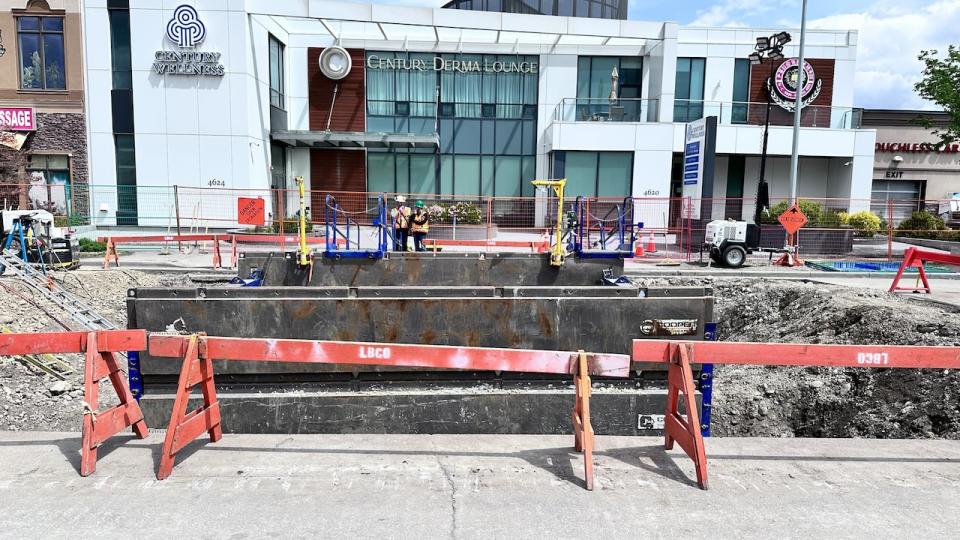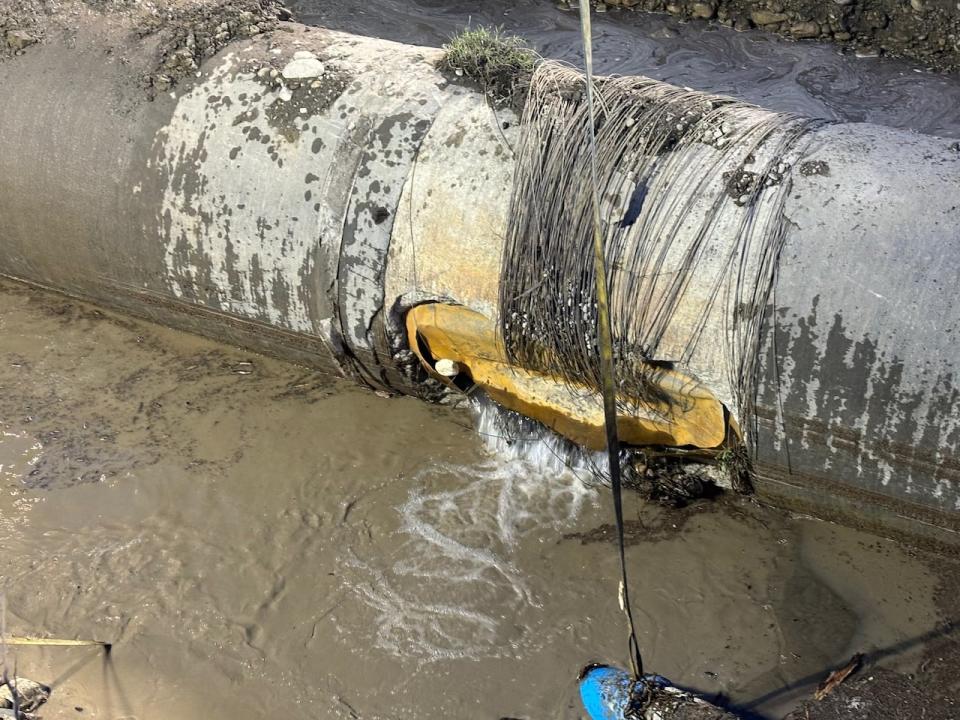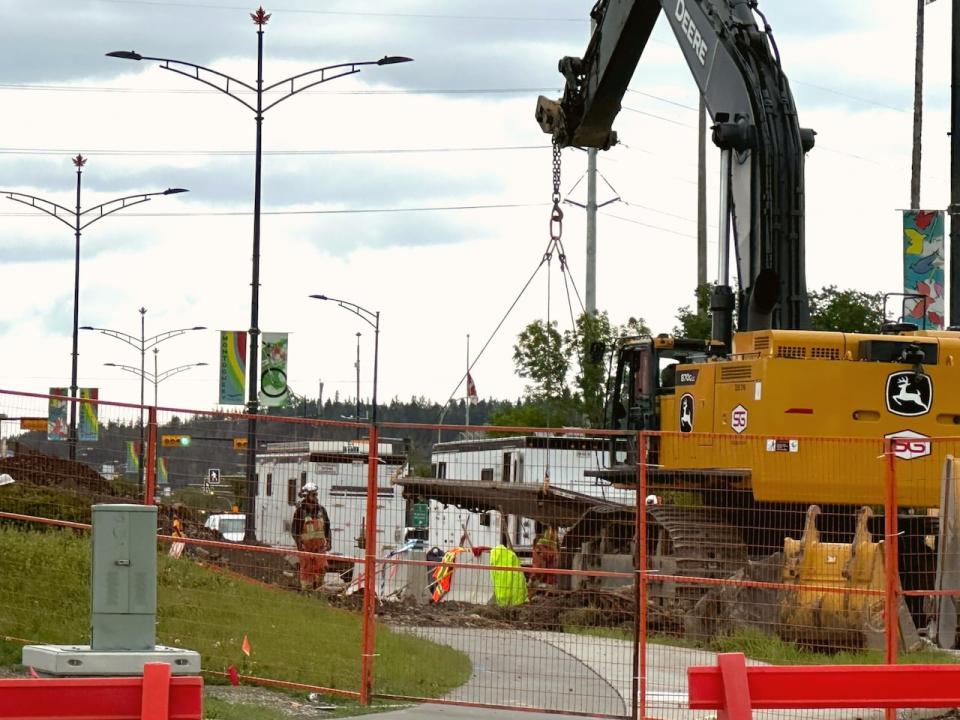Calgary officials aiming for 'low end' of repair timeline after pipes arrive from San Diego
Two key pieces of pipe needed to complete repairs to a water feeder main that ruptured, triggering citywide water restrictions, arrived Tuesday night from San Diego and are being prepped for installation.
City of Calgary officials now say repairs could move quicker than previously expected.
On Wednesday afternoon, the city's general manager of infrastructure services, Michael Thompson, provided an update on the repair timeline.
"As we look at the work completed to date — specifically the excavations and exposing the five sections of pipe — we can now share we are aiming for the low end of our original timeline of three to five weeks, which would be July 5," said Thompson."
"There are still many risks ahead, but every day we work through this complex repair, we become more confident in our timeline."
During the city's Wednesday morning briefing, Mayor Jyoti Gondek thanked the southern California county's water authority, saying a local shop is in the process of sandblasting the pipe and coating it with epoxy to ensure it's ready to go as crews set to work on five "hot spots" along the main that need fixing.
"As we heard yesterday, these hot spots are not leaks, they are sections of the feeder main that needed an immediate repair," Gondek said.
Wednesday marks two weeks since the Bearspaw south feeder main — which is 11 kilometres long and as wide as two metres in parts — suffered a rupture. Since then, Stage 4 water restrictions on outdoor water use were enacted alongside a citywide fire ban.

Responding to questions about why the infrastructure was brought in from San Diego as opposed to it being sourced from somewhere closer, Gondek said the city did consider local options first, but the size of the pipe posed a significant challenge.
"This is not generally the size of pipe that is used in oil and gas operations," she said.
"Generally, if this type of a part is available, it's because an organization that provides water to residents is the one that has it on hand. And that's why the San Diego County Water Authority has been such an important partner for us."
Gondek says the city chose the option that would make repairs faster.
All of this has put a spotlight on water infrastructure, and one expert says the rupture might have something to do with what the water feeder main is made of.
Graham Bell is a research associate professor with the department of Civil and Environmental Engineering at the University of Tennessee. He's also the vice-president of technical services for Structural Technologies, which specializes in the repair of large diameter pipe.
In an interview with CBC Radio's The Current on Tuesday, Bell explained the Bearspaw south feeder main is a prestressed concrete cylinder pipe (PCCP), which is a composite pipe material made primarily out of concrete.
"Most of our pipes were made of a single material, like cast iron, or steel, or maybe slightly reinforced concrete up until about World War II when we needed steel for the war effort," said Bell.
To explain the layers of this PCCP, he says concrete is first cast with a thin steel cylinder inside of it, and that steel cylinder exists as a membrane to keep the water inside the the pipe. Then, it's wrapped with incredibly high-strength steel wires, which Bell says is "about four to five times stronger than the steel can that's on the inside of it."
It's those steel wires that determine the structural capacity of the pipe.
LISTEN | A lesson on prestressed concrete cylinder pipes:
"Those steel wires over time developed some metallurgical problems, and in particular, the pipes manufactured from about 1960 to 1980 have a greater amount of problems than the other pipes outside of that [time period]."
So what happened with those pipes?
Bell says some parameters were changed in the manufacturing process around that time that made the pipes "less robust."
"Now what we're dealing with is these pipes are 40 to 50 years old, they're maturing and they're interacting with the environment, they're deteriorating and they're having problems," he said.
"It's not uncommon for this era of pipe."
PCCP problems?
City officials say the ruptured section of the Bearspaw south feeder main was installed in 1975, though they haven't confirmed the cause of the rupture that occurred on June 5.
"They generally do not leak before they break," added Bell in an interview Wednesday with the Calgary Eyeopener.
He says these high-tension wires are brittle and don't allow for much give.
"They snap, and then that leads to the catastrophic failures that you see and are experiencing."

He says that in 1970s there were some changes to the standards, but it hasn't been a problem since the 1980s once that was corrected
Bell said he's been involved in a number of studies revolving around PCCP. He's aware of roughly 600 examples of catastrophic failures that have occurred since 1968.
"They occur basically wherever prestress was used," he said.
"It just depends on the manufacturing, how much was used. It's not all pipes, not all the wire is bad."
He says the challenge with PCCP is repairing the wires in distress before it becomes a problem, calling the process difficult.
LISTEN | Researcher explains manufacturing issues behind certain water infrastructure:
While repairs continue, officials are still urging Calgarians to continue being water-conscious. Gondek said 450 million litres were used across the city on Tuesday, meaning usage has remained relatively consistent this week.
Over the past two weeks, 600 Olympic-sized swimming pools worth of water have been conserved, according to the mayor.
Gondek thanked Calgarians for "holding the line" and remaining below the safe usage threshold, which is 480 million litres.
River diversion options
On Tuesday, the provincial government issued two temporary diversion licences to the City of Calgary, which now allows for 200,000 cubic metres (200 million litres) for non-potable industrial use via diversion points out of the Bow River.
This means the City of Calgary is now able to track and manage water withdrawals from the river for the duration of those permits.

Ryan Fournier, the press secretary for the provincial ministry of Environment and Protected Areas, said it's an attempt to ease the pressure put on the potable water system because of the critical feeder main break.
During Wednesday afternoon's briefing, Coby Duerr, deputy chief of the Calgary Emergency Management Agency (CEMA), said the city is working closely with the local construction Industry to open two locations along the Bow River to provide non-potable water for construction work.
"This water will be free of charge and will be the responsibility of the end user to ensure that the water is appropriate for its intended application," said Duerr, adding the city would be able to provide more information in the coming days.
"We want to thank the provincial government for expediting the permits needed to help move this program forward quickly."


